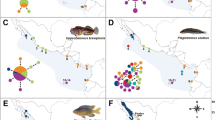Abstract
Tridacna gigas (L.) populations were sampled from 13 locations throughout the west Pacific in 1990–1991 and screened for allozyme variation at seven polymorphic loci. Significant genetic differences were found between the few large stocks of T. gigas remaining in the world. Cluster analysis identified two major regional groups of populations: a “Central Pacific” group consisting of Kiribati and the Marshall Islands, and a “West Pacific” group comprising all other populations. Within the latter group, the Great Barrier Reef populations were significantly differentiated from those in the Solomon Islands. The main routes of gene flow did not run parallel with known major surface currents as might be expected, but crossed them. Gene exchange was limited east-west between the Central and West Pacific groups and the GBR and the Solomon Islands. The lack of correspondence between the major surface currents and the routes of gene flow suggests that the genetic structure of T. gigas reflects historical patterns of migration that no longer occur, rather than presentday dispersal. These findings raise fundamental questions concerning the origin and maintenance of genetic diversity in Pacific faunas, and have important implications for the mariculture and conservation of T. gigas.
Similar content being viewed by others
References
Andrews JC, Clegg S (1989) Coral Sea circulation and transport deduced from modal information models. Deep-Sea Res 36: 957–974
Ayala FJ, Hedgecock D, Zumwalt GS, Valentine JW (1973) Genetic variation in Tridacna maxima, an ecological analog of some unsuccessful evolutionary lineages. Evolution 27: 177–191
Benzie JAH, Williams ST (1992a) No genetic differentiation of giant clam (Tridacna gigas) populations in the Great Barrier Reef Australia. Mar Biol 113: 373–377
Benzie JAH, Williams ST (1992b) Genetic structure of the giant clam (Tridacna maxima) populations from reefs in the Western Coral Sea. Coral Reefs 11: 135–141
Benzie JAH, Williams ST, Macaranas JM (1993) Allozyme electrophoretic methods for analysing genetic variation in giant clams (Tridacnidae). Australian Centre for International Agricultural Research Canberra (Tech Rep No. 23)
Braley RD (1989) Farming the giant clam. Wld Aquacult 20: 7–18
Campbell CA, Valentine JW, Ayala FJ (1975) High genetic variability in a population of Tridacna maxima from the Great Barrier Reef. Mar Biol 33: 341–345
Copland JW, Lueas JS (eds) (1988) Giant clams in Asia and the Pacific, Australian Centre for International Agricultural Research, Canberra (Monograph 9)
Fairbridge RW (Ed) (1966) The encyclopaedia of oceanography, Van Nostrand Reinhold Co., New York
Gershchkov SG, Alexeev VN, Rassokho AI, Faleev BI, Demin LA, Khaetov GM, Seregin MP (eds) (1974) Atlas of the oceans. Main Administration of Navigation and Oceanography. Ministry of Defense of the USSR, Moscow
Harris H, Hopkinson DA (1976) Handbook for enzyme electrophoresis in human genetics. North Holland, Oxford (Looseleaf)
Jackson JBC (1986) Modes of dispersal of clonal benthic invertebrates: consequences for species' distributions and genetic structure of local populations. Bull mar Sci 39: 588–606
Juinio MAR, Menez LAB, Villanoy CL, Gomez ED (1989) Status of giant clam resources of the Philippines. J mollusc Stud 55: 431–440
Kay EA, Palumbi SR (1987) Endemism and evolution in Hawaiian marine invertebrates. Trends Ecol Evolut 2: 183–186
Knowlton N, Jackson JBC (1994) New taxonomy and niche partitioning on coral xeefs: jack of all trades or master of some? Trends Ecol Evolut 9: 7–9
Lucas JS (1988) Giant clams: description distribution and life history. In: Copland JW, Lucas JS (eds) Giant clams in Asia and the Pacific. Australian Centre for International Agricultural Research, Canberra, pp 21–32 (Monograph 9)
Macaranas JM, Ablan CA, Pante MJR, Benzie JAH, Williams ST (1992) Genetic structure of giant clam (Tridacna derasa) populations from reefs in the Indo-Pacific. Mar Biol 113: 231–238
McManus JW (1985) Marine speciation, tectonics and sea-level changes in Southeast Asia. Proc 5th Int coral Reef Congr 4: 133–138 [Gabrié C et al. (eds) Antenne Museum-EPHE, Moorea, French Polynesia]
Miller RG (1966) Simultaneous statistical inference. McGraw-Hill, New York
Nei M (1978) Estimation of average heterozygosity and genetic distance from a small number of individuals. Genetics, Austin, Tex 89: 583–590
Nei M (1987) Molecular evolutionary genetics. Columbia University Press, New York
Palumbi SR (1992) Marine speciation on a small planet. Trends Ecol Evolut 7: 114–115
Pollock DE (1992) Palaeoceanography and speciation in the spiny lobster genus Panulirus in the Indo-Pacific. Bull mar Sci 51: 135–146
Potts DC (1983) Evolutionary disequilibrium among Indo-Pacific corals. Bull mar Sci 33: 619–632
Richardson BJ, Baverstock PR, Adams M (1986) Allozyme electrophoresis A handbook for animal systematics and population studies. Academic Press, North Ryde, Australia
Rosenblatt RH, Waples RS (1986) A genetic comparison of allopatric populations of shore fish species from the eastern and central Pacific Ocean: dispersal or vicariance? Copeia 1986: 275–284
Scheltema RS, Williams IP (1983) Long-distance dispersal of planktonic larvae and the biogeography and evolution of some Polynesian and western Pacific mollusks. Bull mar Sci 33: 545–565
Skibinski DOF, Woodwark M, Ward RD (1993) A quantitative test of the neutral theory using pooled allozyme data. Genetics, Austin, Tex 135: 233–248
Springer VG (1982) Pacific plate biogeography, with special reference to shorefishes. Smithson Contr Zool 367: 1–181
Springer VG, Williams JT (1990) Widely distributed Pacific plate endemics and lowered sea level. Bull mar Sci 47: 631–640
Swofford DL, Selander RB (1981) BIOSYS-1: a Fortran program for the comprehensive analysis of electrophoretic data in population genetics and systematics. J Hered 72: 281–283
Waples RS (1987) A multispecies approach to the analysis of gene flow in marine shore fishes. Evolution 41: 385–400
Weir BS, Cockerham CC (1984) Estimating F-statistics for the analysis of population structure. Evolution 38: 1358–1370
Yonge CM (1975) Giant clams. Scient Am 232: 96–105
Author information
Authors and Affiliations
Additional information
Communicated by G.F. Humphrey, Sydney
Rights and permissions
About this article
Cite this article
Benzie, J.A.H., Williams, S.T. Gene flow among giant clam (Tridacna gigas) populations in Pacific does not parallel ocean circulation. Marine Biology 123, 781–787 (1995). https://doi.org/10.1007/BF00349121
Received:
Accepted:
Issue Date:
DOI: https://doi.org/10.1007/BF00349121




